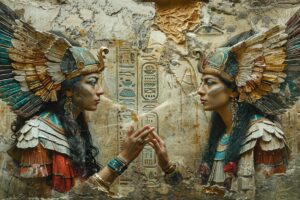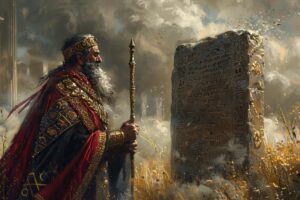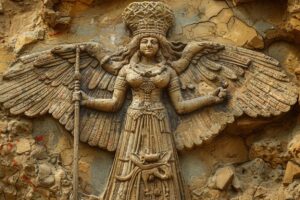Arinna Sun Goddess: Origins, Worship, and Symbolism in Hittite Culture

The Arinna Sun Goddess, known as Arinnitti or Wurušemu, held a central role in Hittite religion. Originating from the Hattian culture, she became a key figure in the Hittite pantheon, representing both the sun and the earth.
Her worship was closely linked to the state and monarchy, legitimizing royal power. Major temples dedicated to her existed in Arinna and Ḫattuša, where rituals and offerings, including solar discs and animal sacrifices, were performed.
Origins and Evolution
The Arinna Sun Goddess has origins rooted deep in the Hattian culture and later became integral to Hittite society. Her connection to the sacred city of Arinna highlights her significance.
The Hattian Roots
The Arinna Sun Goddess originated from the ancient Hattian culture that predated the Hitites. Known as Eštan among the Hattians, her worship included significant chthonic and fertility aspects. One of her Hattian epithets, Wurunšemu, is believed to mean “Mother of the Earth.”
Integration into Hittite Culture
As the Hittites rose to prominence in Anatolia, they assimilated many elements of Hattian religion. The goddess Eštan was incorporated into the Hittite pantheon under the name Ištanu. This process involved syncretizing her attributes with those of Hittite deities, solidifying her as a central figure in Hittite worship.
Arinna: The Sacred City
Arinna, often called “The City of the Gods,” was a crucial religious hub for the Hittites. It was one of three major religious centers in the empire. The inaugural coronations of Hittite kings took place here, underscoring the city’s significance.
Temples dedicated to the Arinna Sun Goddess were prominent features of the city.
Role in Mythology
The mythological role of the Arinna Sun Goddess is deeply intertwined with other deities and significant stories from Hittite culture.
Pairing with Weather God Tarḫunna
The Arinna Sun Goddess forms a divine partnership with the weather god Tarḫunna. Together, they are revered as the highest deities in the Hittite pantheon.
Family and Relations
The goddess and Tarḫunna have several divine offspring, including Mezulla, Zintuḫi, the weather gods of Nerik and Zippalanda, and the grain god Telipinu. An eagle serves as the goddess’s messenger.
Significant Myths and Stories
The Construction of Her House
A Hattian myth fragment recounts the building of her house in Liḫzina, highlighting her esteemed status among the gods.
The Blood-Red Apple Tree
Another myth describes a blood-red apple tree seen by the goddess. She decorates it with her shining wand, illustrating her connection to nature’s marvels.
Function in Hittite Religion
The Sun Goddess of Arinna played a critical role in Hittite religious practices, particularly in the context of royal authority and the state.
Patronage of the State and Monarchy
As a patron of the state, this deity was deeply integrated into the monarchy. She was seen as a maternal figure who provided legitimacy and protection to the king.
Royal Ideology and Symbolism
Blessings and Legitimacy
The king’s authority was legitimated through blessings from the goddess.
It was believed that the land belonged to the goddess and the weather god, who then entrusted it to the king. This relationship underscored the divine right of kingship.
Royal Prayers and Hymns
Hittite kings often conducted prayers at sunset, seeking the favor and guidance of the Sun Goddess.
These prayers are some of the earliest known texts and played a significant role in reinforcing the sacred connection between the deity and the monarchy.
- The prayer of King Arnuwanda I
- The renowned prayer by Queen Puduḫepa
Worship and Cult Practices
The worship and cult practices dedicated to the Arinna Sun Goddess were integral to Hittite religion, emphasizing rituals, offerings, and important temples.
Major Temples and Worship Sites
The primary temple dedicated to the Arinna Sun Goddess was located in the sacred city of Arinna. Another significant worship site was in the citadel of Ḫattuša.
These temples were focal points for many religious activities and played a key role in royal ceremonies and state rituals.
Rituals and Offerings
Rituals and offerings were essential aspects of worship for the Arinna Sun Goddess. Various practices were undertaken to honor and appease her.
Animal Sacrifices
Animal sacrifices were a common form of offering. The king Ulmi-Teššup of Tarḫuntašša annually sacrificed a bull and three sheep to the goddess. This was done to seek her favor and ensure the prosperity of the state.
The cierva, or deer, was particularly sacred to the goddess. Queen Puduḫepa promised to dedicate many deer as part of her devotions.
Solar Discs and Artifacts
Solar discs were significant symbols associated with the Arinna Sun Goddess. In the city of Tarḫurpa, multiple solar discs were venerated, many of which were donated by Hittite queens.
The king Ulmi-Teššup donated intricately crafted solar discs made of gold, silver, and copper annually.
These artifacts underscored the divine connection between the royalty and the goddess.
Cult vessels and statuettes, including those shaped like deer, were also used in rituals. Some of these items have been found in various archaeological sites, revealing their importance in ancient worship practices.
Representation and Symbols
The Sun Goddess of Arinna was depicted in various forms and her symbols played a key role in her worship. Different sacred animals and items were significant in her representation.
Depictions of the Goddess
The goddess was often shown as a solar disk, a common symbol in Hittite religion representing the sun.
In some representations, she appeared as a woman with a halo, embodying her divine nature.
Sacred Animals and Items
Certain animals and items were intimately connected with the Sun Goddess of Arinna and featured prominently in her worship.
The Significance of the Deer
The deer was a sacred animal for the goddess. It symbolized her connection to nature and fertility. Queen Puduḫepa, among others, dedicated many deer to her in rituals.
Cult Vessels and Statuettes
Various cult items were used in her worship.
Statuettes often depicted the goddess seated with a halo. Cult vessels in the form of deer were used for offerings. These items highlighted the divine status and attributes of the goddess.
Syncretism and Cultural Integration
The Hittite civilization experienced cultural exchanges with neighboring regions, leading to the syncretism and integration of deities like the Arinna Sun Goddess with other cultural pantheons.
Fusion with Hepat
During the New Kingdom, the Arinna Sun Goddess was identified with the Syrian-Hurrian goddess Hepat. This syncretism is evident in various religious texts, including the prayers of Queen Puduḫepa, who invoked both names.
This fusion highlights the profound blending of beliefs between the Hittites and their neighboring cultures.
Influence of Neighboring Cultures
Syrian and Hurrian Connections
The influence of Syrian and Hurrian cultures on the Hittites led to the adoption and adaptation of various deities and religious practices. The intersection of these cultures is particularly noticeable in the syncretism of the Arinna Sun Goddess with foreign deities, reflecting an advanced level of religious and cultural integration.
Impact on Hittite Religious Cohesion
The integration of deities from neighboring cultures did not only signify religious blending but also supported the cohesion and stability of the Hittite state by incorporating and respecting foreign beliefs.
This practice helped unify the diverse regions under Hittite control, creating a more cohesive and culturally integrated empire.
Prominent Figures and Devotees
The Arinna Sun Goddess had many devoted followers, particularly among the Hittite royal family. These prominent figures played essential roles in maintaining her worship and integrating her into state affairs.
Queen Puduḫepa’s Devotion
Queen Puduḫepa was one of the most devout followers of the Arinna Sun Goddess. She considered herself protected by the deity and often depicted herself embraced by her. Puduḫepa dedicated several prayers to the goddess and played a crucial role as a priestess, serving as an intermediary between the deity and the people.
Role of Other Royals
Kings’ Dedications
Hittite kings consistently showed their devotion to the Arinna Sun Goddess. For instance, King Ulmi-Teššup of Tarḫuntašša annually donated a solar disc made of gold, silver, and copper, along with a bull and three sheep.
These dedications were part of their efforts to seek blessings and legitimacy from the goddess.
Royal Patronage Over Time
Throughout the Hittite Empire, royal patronage of the Arinna Sun Goddess remained steadfast. Kings and queens alike engaged in various rituals and offerings to honor her, ensuring her continued favor.
This long-term dedication underscored the goddess’s importance in upholding the monarchy’s divine right and political stability.
Controversies and Interpretations
The study of the Arinna Sun Goddess involves many controversies and varying interpretations. Differences in ancient texts and modern scholarly debates contribute to a complex understanding of this deity.
Confusions with Other Solar Deities
The Arinna Sun Goddess is often confused with other solar deities from neighboring cultures.
Differences in names and attributes can create overlap and misunderstanding, particularly with deities such as the Hurrian Hepat and the various solar deities of Syrian origin.
Modern Scholarly Debates
Scholars continue to debate various aspects of the Arinna Sun Goddess, ranging from her origins to her cultural integration.
Variations in Deity Names
There are numerous variations in the names used for the Arinna Sun Goddess. Some texts refer to her as Arinnitti, while Hattian sources call her Wurušemu. This makes it challenging to pinpoint her exact identity.
Divergent Interpretations of Texts
Ancient hit texts related to the Arinna Sun Goddess are often fragmentary and open to interpretation. Different scholars interpret these texts in multiple ways, which contributes to ongoing debates about her mythology, symbolism, and role in Hittite religion.
FAQs about Arinna Sun Goddess
This section provides answers to common questions about the Arinna Sun Goddess and clarifies various aspects of her worship practices.
Common Questions from Visitors
Here are some frequently asked questions regarding the Arinna Sun Goddess:
- Who was the Arinna Sun Goddess?
- What was her role in Hittite mythology?
- Where were the major temples dedicated to her?
- How did she influence the Hittite royalty?
- Was she associated with other deities?
Clarifications on Worship Practices
What Objects Were Used?
Various objects played a role in the worship of the Arinna Sun Goddess.
These included:
- Solar discs made of gold, silver, and copper
- Animal figurines, particularly of deer
- Cult vessels in the shape of deer
- Offerings of bulls and sheep
How Were Rituals Conducted?
Rituals dedicated to the Arinna Sun Goddess involved several key practices:
- Daily prayers and hymns by the kings and queens
- Animal sacrifices, mainly of bulls and sheep
- Offering solar discs as tributes
- Performing ceremonies at major temples in Arinna and Ḫattuša
These rituals were essential in maintaining the favor of the goddess and ensuring the continued legitimacy and prosperity of the Hittite state.





















